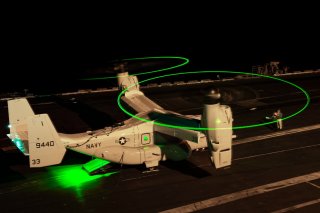New Naval Aircraft Quickly Becomes Vital Asset to American Sailors
The U.S. Navy constructed the CMV-22B aircraft, based on the Marine Corps’ tiltrotor aircraft, which has quickly become a crucial asset to carrier operations of extreme distances.
The United States Navy’s CMV-22B Osprey, a variation of the Marine Corps’ pioneering tiltrotor aircraft, is swiftly becoming a vital asset for America’s Sailors.
“With distributed maritime ops, longer ranges, distances between multi-carrier operations, distances from land-based areas, and the ability for the CMV- 22B to plop down on unimproved spaces, it proved to be a game-changer for us on deployment,” Vice Admiral Kenneth Whitesell, the commander of Naval Air Forces (NAVAIR) and Naval Air Force, U.S. Pacific Fleet, said during a Maritime Security Dialogue event on Wednesday.
The CMV-22B replaces the Navy’s aging C-2A Greyhound transport carrier-onboard-delivery aircraft. Though the Greyhound is capable of carrier landings, it cannot be refueled from the air and has been in service since the 1960s.
Compared to the Marine Corps V-22 Osprey, the navalized variant has an increased fuel capacity, giving it a much greater range than the base Osprey. In addition, it offers about 150 miles greater range than the Greyhound.
By nature of its helicopter-like landing, the Osprey can conduct night landings on aircraft carriers more easily than the Greyhound, which is also an asset to rapid landing, unloading, reloading, and takeoff procedures.
The Osprey has the “ability to get it on and off the deck In a rather rapid fashion,” Vice Admiral Whitesell said. “I don't have to clean catapults three and four and land to [carrier onboard delivery] COD. I can now land it just like a helicopter. I can reposition it. As soon as it offloads, or prior to onload, I can take it back into starboard delta [holding pattern].”
“This past summer marked the first deployment for the CMV-22B. Fleet Logistics Multi-Mission Squadron (VRM) 30 embarked on the USS Carl Vinson (CVN 70) alongside the F-35C Lightning II and E-2D Advanced Hawkeye squadrons,” a press release from the U.S. Navy in February explained.
“The first deployed detachment has executed a mission completion rate of 98% and a mission capable rate of 75%. The CMV-22B is a crucial element of future carrier airwings due to the cargo capacity needed to transport F-35 power modules and additional logistics support for future carrier air wing deployments with next-generation platforms.”
Still, the CMV-22B offers higher readiness than its predecessor.
“For COD, you always have one in phased maintenance,” Vice Admiral Whitesell said, referencing a specialized Naval maintenance schedule.
“So even with the C-2, you always had about 66% mission capability. And sure enough, with CMV-22, our maintenance schedule for the inaugural deployment was exactly the same. We still had about 67% mission capability rate as we had one of the platforms in phased maintenance. But now we were looking at the class maintenance plan for every platform that we have.”
Caleb Larson is a multimedia journalist and defense writer with the National Interest. A graduate of UCLA, he also holds a Master of Public Policy and lives in Berlin. He covers the intersection of conflict, security, and technology, focusing on American foreign policy, European security, and German society for both print and radio. Follow him on Twitter @calebmlarson
Image: Flickr.

